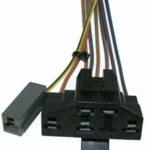Dealing with a P0420 code on your 2001 Toyota Sienna and the dreaded “cat not ready” status in your OBD2 system? Many assume it immediately points to a failed catalytic converter. However, before you rush to replace it, consider this: it might not actually be your Sienna’s catalytic converter at fault.
The P0420 code arises because your car’s computer monitors the catalytic converter’s efficiency using oxygen sensors. One sensor is placed before the catalytic converter, and another after. The computer compares the signals from these sensors to determine if the converter is working effectively. If the difference isn’t within the expected range, the P0420 code is triggered, suggesting catalyst inefficiency. But this system isn’t foolproof.
Often, the issue isn’t the catalytic converter itself, but a faulty sensor. On many occasions, especially with older vehicles like a 2001 Sienna, replacing a malfunctioning air/fuel sensor or oxygen sensor can resolve the P0420 code and clear the “cat not ready” status. Some mechanics, unfortunately, may jump to the conclusion of a necessary catalytic converter replacement – sometimes unnecessarily. A truly skilled mechanic will use tools like a storage scope to analyze the sensor signals and accurately diagnose the root cause before recommending expensive repairs.
When do catalytic converters genuinely fail? There are primary reasons:
- Rich Running Condition: If your Sienna’s engine is running too rich (too much fuel), excessive heat can damage the catalytic converter element. A “rich running” condition should ideally trigger other diagnostic codes, alerting you to this problem.
- Oil Contamination: Oil leaks can lead to oil entering the exhaust system and clogging the catalytic converter, reducing its efficiency.
- Physical Damage: Impact from road debris can physically damage the converter.
While some products claim to clean catalytic converters, including liquids sold in auto repair markets, proceed with caution. Avoid unverified methods like using lacquer thinner, as incorrect usage can cause further damage.
Before assuming the worst with your 2001 Sienna’s catalytic converter, explore the possibility of sensor issues. Accurate diagnosis by a competent mechanic can save you from unnecessary and costly catalytic converter replacements when a simple sensor fix might be all that’s needed to get your OBD2 system “ready” and your Sienna running smoothly again.

